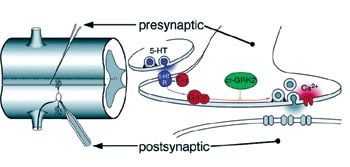
The investigators used a lamprey eel spinal cord system (left) to study nerve cell communication. The drawing on the right shows a presynaptic nerve terminal with the hypothesized signaling events evoked by serotonin (5-HT). The researchers found that G beta-gamma (Gbg) regulates synaptic vesicle fusion.
Neurons talk in
a new way: study
A group of researchers led by Heidi E. Hamm, Ph.D., professor and chair of Pharmacology, has discovered another layer of regulation in the already complex world of nerve cell communication. The findings, reported April 13 in Science, point to a new mode of action for a large class of neurotransmitter molecules that shape neuronal communication.
Nerve cells communicate with each other across a small gap called a synapse. The presynaptic neuron releases packets of chemical neurotransmitters, which act on receptors that stud the surface of the postsynaptic neuron to send along a message.
It has been known for some time, Hamm said, that one way neurotransmitters like opiates, dopamine, serotonin, and adrenaline regulate brain activity is by working through receptors on the presynaptic neuron to reduce the amount of neurotransmitter it releases.
“Presynaptic inhibition is a very important part of shaping synaptic responses and of the mechanisms involved in learning and memory,” Hamm said.
While Hamm was at Northwestern University, her group collaborated with Simon Alford at the University of Illinois at Chicago to study the molecular events underlying presynaptic inhibition. They studied a unique model system – a giant synapse in the spinal column of lamprey eels. Using electrophysiological techniques, they injected proteins into the presynaptic neurons and recorded responses from the postsynaptic cell.
“It has been difficult to study synapses directly, because they’re so tiny,” Hamm said. “This giant synapse system really made it possible for us to do these studies.”
Hamm and colleagues were interested in the role of a protein combo called G beta-gamma, a subunit of molecular switches called G proteins. G proteins pass signals along from activated receptors at the cell surface to other proteins inside the cell. Their importance is underscored by the fact that more than half of the drugs in the pharmaceutical armamentarium are directed at receptors that control G proteins.
Hamm and others thought that G beta-gamma played a role in presynaptic inhibition by modulating the amount of calcium entering the cell. Calcium regulates the fusion of synaptic vesicles – bubble-like neurotransmitter-carrying packets – with the nerve cell membrane. When fusion occurs, the vesicles burst and release their neurotransmitter contents into the synapse. The dogma in the field, Hamm said, held that G proteins limited calcium entry and therefore reduced fusion and neurotransmitter release.
But instead of controlling calcium entry, the investigators found that G beta-gamma works closer to, and potentially directly on, the synaptic vesicle fusion apparatus itself. They showed that G beta-gamma binds to the fusion machinery; they are working now to prove that it functionally blocks vesicle fusion and thereby inhibits neurotransmitter release.
“This is very exciting because it’s really a completely new way to think about G protein regulation of synaptic events in the brain,” Hamm said. “There’s a lot known about synaptic fusion, but there’s not a lot known about the regulation of it.
“G proteins may play a crucial role in regulating fusion events, not only in the brain but in the trafficking of vesicles in other cell types as well.”
Investigators participating in the Science research include Trillium Blackmer, Eric C. Larsen, Michiko Takahashi, and Thomas F. J. Martin. The research was supported by the National Institutes of Health.













